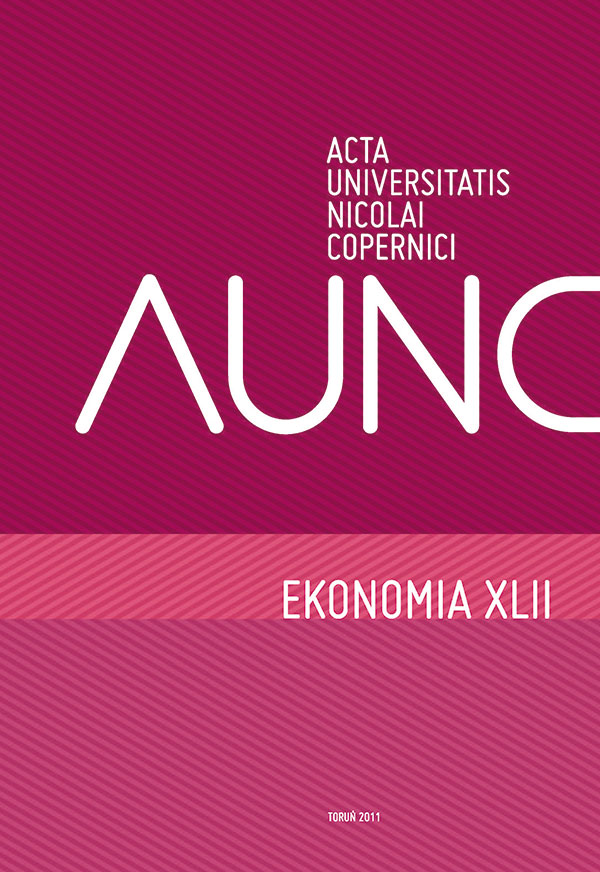Ownership structure of corporation as a key factor of potential development
DOI:
https://doi.org/10.12775/AUNC_ECON.2011.006Keywords
company, the ownership structure of companies, the institutionalization of corporate ownership, corporate ownership concentration, the company developmentAbstract
The main aim of the study was to analyze changes in ownership structures of modern joint-stock companies and assess their impact on relations intra-corporate. In the first part of the paper presents the process of change that is occurring in European and global companies for at least thirty years. It is a process of institutionalization of corporate ownership, and the progressive concentration of ownership. In the second part focuses on the development of these processes, resulting danger of abuse by dominant shareholders, who have not only a dominant share in the ownership, but also take full control over the functioning of the company. This situation has a strong influence on relations intra-corporate, especially to protect the interests of the company and the interests of minority shareholders. At the end of the article author reminded conclusions of his paper.References
Becht M. (1997), Strong Blockholders, Weak Owners and the Need for European Mandatory Disclosure, European Corporate Governance Network, Executive Report.
Becht M., Röell A. (1999), Blockholdings in Europe: An international comparison, “European Economic Review”, nr 43.
Black A., Wright P., Bachman J.E. (2001), W poszukiwaniu wartości dla akcjonariuszy. Dom Wydawniczy ABC, Warszawa.
Demb A., Neubauer F. (1992), Corporate Governance: Lifespace and Accountability, in: The Corporate Board: Confronting the Paradoxes, Oxford University Press, Nowy Jork.
Facio M., Lang L.H.P. (2002), The ultimate ownership of Western European corporations, „Journal of Financial Economics”, No. 65. DOI: < ahref="http://dx.doi.org/10.1016/S0304-405X(02)00146-0">http://dx.doi.org/10.1016/S0304-405X(02)00146-0.
Fama E.F., Jensen M.C. (1983), Agency problems and residual claims. „Journal of Law and Economics”. DOI: http://dx.doi.org/10.1086/467038.
Franks J., Mayer C. (1994), The ownership and control of German corporations, London Business School, Unpublished manuscript. DOI: http://dx.doi.org/10.1093/rfs/14.4.943.
La Porta R., Lopez-de-Silanes F., Shleifer A. (1999), Corporate Ownership Around the World, “Journal of Finance”, nr 2. DOI: http://dx.doi.org/10.1111/0022-1082.00115.
Morck R., Nakamura M. (1999), Banks and corporate control in Japan, „Journal of Finance”, No. 54. DOI: http://dx.doi.org/10.1111/0022-1082.00106.
Pedersen T., Thomson S. (1997), European patterns of corporate ownership: a twelve country study. „Journal of International Business Studies”, vol. 28, No 4. DOI: http://dx.doi.org/10.1057/palgrave.jibs.8490118.
Roe M. (1994), Strong Managers Weak Owners: The Political Roots of American Corporate Finance, Princeton University Press, Princeton (N. J.)
Shleifer AVishny., R.W. (1997), A survey of corporate governance. „Journal of Finance”, No 52 (2). DOI: http://dx.doi.org/10.2307/2329497.
Tamowicz P., Dzierżanowski M. (2001), Własność i kontrola polskich korporacji, Instytut Badań na Gospodarką Rynkową, Gdańsk.
Ussem M. (1996), Shareholders as a Strategy Asset, „California Management Review”, vol. 39, No. 1. DOI: http://dx.doi.org/10.2307/41165874.
Downloads
Published
How to Cite
Issue
Section
License
Autorzy, których teksty zostaną przyjęte do publikacji, po uzyskaniu pozytywnych recenzji wydawniczych oraz zaakceptowaniu do publikacji przez Komitet Redakcyjny, podpisują umowę licencyjną.
Stats
Number of views and downloads: 2729
Number of citations: 0



